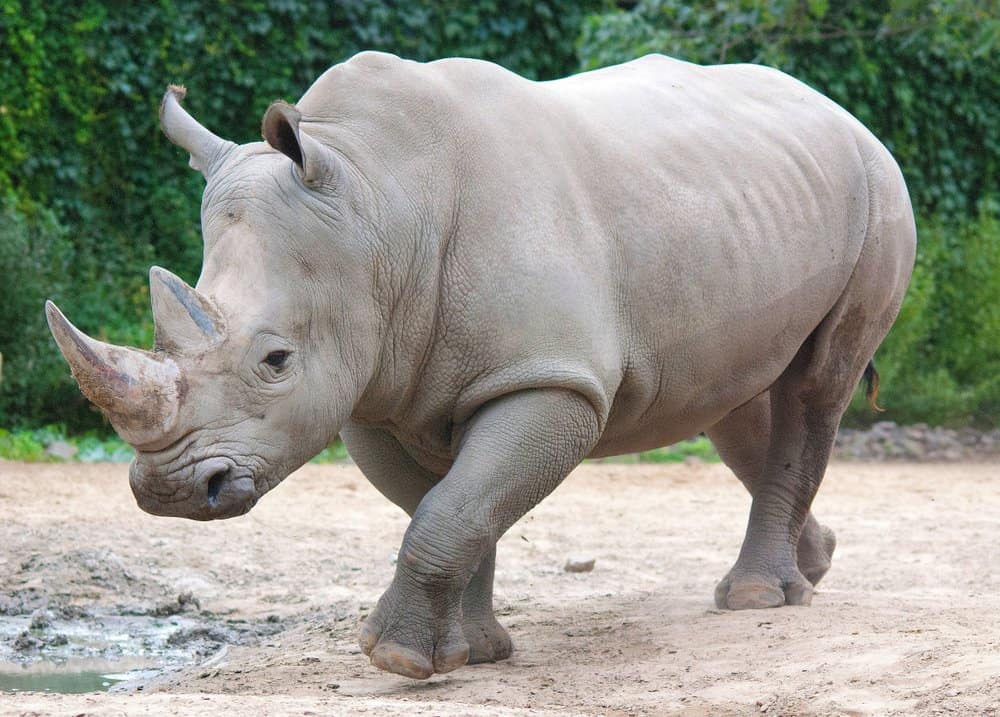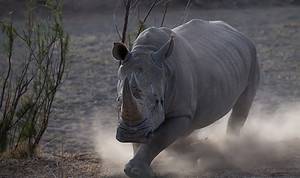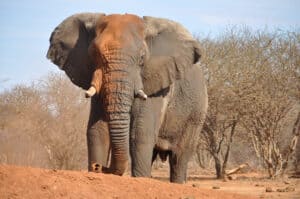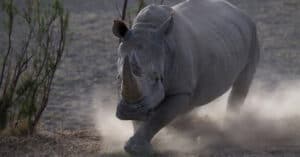Rhinoceros are giant, commanding animals found in Southeast Asia and Africa. But one of the most incredible rhinoceros facts is its horn. Unfortunately, the horn of this majestic creature ensures that it is a prize target of poachers. Regrettable rhinoceros facts include three species landing on the critically endangered list because of poaching. But let’s find out more about the beautiful rhino.
1. There Are Five Species Of Rhino

Rhinoceros facts include five species, white, black, Indian, Sumatran, and Javan rhinos, and white rhinos have the highest numbers.
©meunierd/Shutterstock.com
The various species of rhinos differ in size and physical features. These species are the:
- White rhino. The white rhinos are native to Africa and have two species: the southern white rhino and the northern white rhino. The white rhino population is safe from extinction, but the last northern rhino died in 2018.
- Black rhino. The black rhinos have a triangular top lip and are critically endangered.
- Indian rhino. The Indian rhino is the largest in Asia and lives in the foothills of the subcontinent. They have a single horn and skin that looks like armor.
- Sumatran rhino. The Sumatran rhino is the smallest rhino species and has hair that covers its entire body. They used to live in India and Borneo but now live in isolated parts of the jungles.
- Javan rhino. The Javan rhino is critically endangered. For their protection, they only live in a single nature reserve in Indonesia called Ujung Kulan National Park.
2. Rhinoceros Facts – They Live In Forests and Savannas
Rhinos inhabit the forests and savannas of Southeast Asia and Africa. These regions contain a wide variety of food sources and shelter, making them ideal for rhinos. And while black rhinos live from South Africa to Ethiopia in natural reserves, the Indian rhino lives in grasslands and forests near the foothills of the Himalayas. In contrast, the Sumatran and Javan rhinos thrive in dense forest areas. However, the Javan rhino only lives in a single nature reserve where conservation efforts focus on reviving their numbers.
3. Rhinoceros Fun Facts: The Second Largest Land Animal
The elephant is the largest land animal, making the rhino the second largest. Rhinos are black, grey, or brown and have a cylindrical body, a big head, short legs, and a short tail. Besides their stout bodies, they have a giant horn in the middle of their face. Some species even have a second, smaller horn on their face. Other rhinoceros fun facts are that these animals have excellent hearing and a strong sense of smell but poor eyesight.
4. Rhinos Are HEAVY

Rhinoceros fun facts mean that these animals are heavy, weighing an average of 1.5 tons.
©EcoPrint/Shutterstock.com
Rhinoceros facts must describe how heavy these animals are, no matter the species. The rhino varies in size and weight, but on average, they weigh 1.5 tons.
- White rhinos weigh between 3,100 and 7,900 pounds
- Black rhinos weigh between 1,800 and 3,100 pounds
- Indian rhinos weigh between 4,900 and 6,600 pounds
- Javan rhinos weigh between 2,000 and 5,100 pounds
- Sumatran rhinos weigh between 1,100 and 1,800 pounds
5. What Is A Rhino Horn Made From?
Rhinos have one or two large horns in the middle of their faces, which are made of keratin. Keratin is also a primary element of human hair and nails. The white, black, and Sumatran rhinos have two horns, while the Indian and Javan rhinos have one horn. Sometimes, the female Javan rhino will lack a horn or only have a bump on her nose. Poachers frequently target rhinos for their horns, as many cultures use them in traditional medicines, believing they have healing properties. The most prominent rhino horn ever recorded came from a white rhino that grew to 59 inches long.
6. Rhinoceros Facts: Species Populations Vary
The black, Sumatran, and Javan rhino species are critically endangered. In 2019, the International Rhino Foundation found only 5,500 black rhinos, 80 Sumatran rhinos, and 72 Javan rhinos left on the planet. The Indian rhino is listed as vulnerable, having 3,600 individuals left on the earth. In contrast, the white rhino has the highest numbers but is still listed as near threatened. Altogether, there are 18,000 white rhinos left on the planet. All the rhino species have increased their populations since 2009, except the Sumatran rhino. This species still suffers from poaching, and its numbers decreased from 250 to 80 rhinos between 2009 and 2019.
7. Many Subspecies of Modern Rhino Have Gone Extinct

The Vietnamese Javan rhino subspecies became extinct in 2010.
©NormanCook/Shutterstock.com
There is only one surviving subspecies of the Javan rhino. Poachers killed the last Vietnamese Javan rhino, a subspecies, in 2010. Additionally, a subspecies of Sumatran rhino in Malaysia went extinct in 2019 when the last pair died. The last Northern white rhino died in 2018, and the subspecies with it. The Western black rhino was declared extinct in 2011 after the last sighting of this subspecies occurred in 2001. No rhino species have gone extinct since the Woolly rhinoceros died in 8,000 BC.
8. Rhinos Are Herbivores
These large herbivores eat plant materials like grasses, leaves, shoots, buds, and fruits. And while the rhinoceros may be herbivores and docile, it becomes aggressive when threatened or under attack. However, adult rhinos do not face many predators like their young. Young rhinos often face attacks from predators like lions, pumas, and crocodiles. When this happens, their mother will often defend them by charging toward the predator.
9. Female Rhinos Are Pregnant for Almost 15 Months
Female rhinos have the most prolonged pregnancy of all animals, which is roughly 450 days. In one case, a captive white rhino was pregnant for 548 days. Because of the lengthy gestation period, rhinos only give birth to a calf once every three to five years. And also, because of this, reviving dwindling rhino populations is a significant challenge for conservationists. Rhinos live long lives, between 35 and 50 years old. The oldest rhino in captivity was a white rhino who died at 55 years.
10. Rhinos Can Communicate With Each Other
Rhinos communicate through noises like growls, trumpet calls, snorts, sneeze-like calls, and screams. When rhinos are aggressive, they growl and make trumpet calls. When angry, they emit sneeze-like calls and scream when scared. Rhinos also communicate through urination and defecation. If a rhino urinates and defecates in the same place as other areas, that area becomes the communal latrine. Rhinos also spray dung and urine to mark their territory. Another rhinoceros fact is that they use body language to communicate. To show affection, they rub their sides and demonstrate their aggression by bashing their heads. When curious, they erect their ears and tails.
The photo featured at the top of this post is © iStock.com/EcoPic
Thank you for reading! Have some feedback for us? Contact the AZ Animals editorial team.






